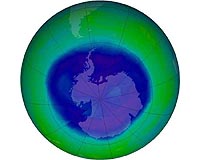| . |  |
. |
Geneva (AFP) Sept 16, 2009 The World Meteorological Organisation said Wednesday that the ozone hole is expected to be smaller in 2009 than a year ago. "The meteorological conditions observed so far could indicate that the 2009 ozone hole will be smaller than those of 2006 and 2008 and close to that of 2007," said the UN agency in a statement. The hole in the layer over the Antarctic was discovered in the 1980s. It regularly tends to form in August, reaching a maximum size late September or early October before it fills again in December. The size is dependent on weather conditions. This year, the hole began forming "earlier than before," said WMO's expert on the ozone Geir Braathen. On September 16, it stood at 24 million square kilometers, he said. In 2008, the maximum reached was 27 million square km while in 2007, the maximum was 25 million square km. Experts have warned that the damage to the ozone layer, which shields the Earth from harmful ultra-violet rays, is so bad that it will only attain full recovery in 2075. Ozone provides a natural protective filter against harmful ultra-violet rays from the sun, which can cause sunburn, cataracts and skin cancer as well as damage vegetation. Its depletion is caused by extreme cold at high altitude and a particular type of pollution, from chemicals often used in refrigeration, some plastic foams, or aerosol sprays, which have accumulated in the atmosphere. Most of these chemicals, chlorofluorocarbons (CFCs), are being phased out under the 1987 Montreal Protocol, but they linger in the atmosphere for many years. Share This Article With Planet Earth
Related Links All about the Ozone Layer
 Ozone: Climate change boosts ultraviolet risk for high latitudes
Ozone: Climate change boosts ultraviolet risk for high latitudesParis (AFP) Sept 6, 2009 Climate change will disrupt Earth's precious ozone layer, boosting ultraviolet (UV) radiation in the deep southern hemisphere and reducing UV in far northern latitudes, a study warned on Sunday. By century's end, UV levels in Antarctica could rise by up to 20 percent at seasonal peaks while average exposure in northern Scandinavia, Siberia and northern Canada could fall by almost a tenth. ... read more |
|
| The content herein, unless otherwise known to be public domain, are Copyright 1995-2009 - SpaceDaily. AFP and UPI Wire Stories are copyright Agence France-Presse and United Press International. ESA Portal Reports are copyright European Space Agency. All NASA sourced material is public domain. Additional copyrights may apply in whole or part to other bona fide parties. Advertising does not imply endorsement,agreement or approval of any opinions, statements or information provided by SpaceDaily on any Web page published or hosted by SpaceDaily. Privacy Statement |